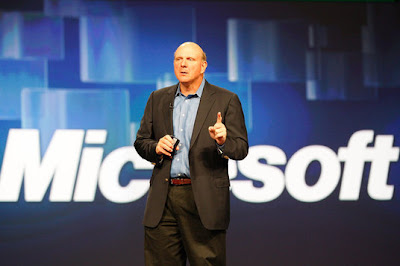Over the past year, Microsoft CEO Steve Ballmer has hinted at a shift in Microsoft's business strategy, from a software focus to a "devices and services" model. With his letter to Microsoft shareholders, we have the first official confirmation that that is indeed the case. Unfortunately, this strategy also creates a conflict of interest that may cause significant problems.
First, let's take a look at the relevant paragraph from Steve Ballmer's letter:
Last year in this letter I said that over time, the full value of our software will be seen and felt in how people use devices and services at work and in their personal lives. This is a significant shift, both in what we do and how we see ourselves — as a devices and services company. It impacts how we run the company, how we develop new experiences, and how we take products to market for both consumers and businesses. The work we have accomplished in the past year and the roadmap in front of us brings this to life.
This is a clear message that Microsoft's hardware forays with the Surface tablet and rumored Surface smartphone are more than just "reference designs". "Devices & services" currently contribute less than 20% to Microsoft's topline, so this isn't exactly a minor shift. However, the challenge of engineering this shift is relatively small compared to the challenge of maintaining OEM relationships that were responsible for Microsoft's success.
An integrated "devices and services" strategy could work if a company uses either proprietary or license-free (open source) software, like Apple & Google do. Unfortunately, Microsoft's entire business model with the Windows OS is based on licensing software to OEMs. Continuing this model in the midst of this shift would mean that Microsoft, as a software vendor, would be competing with their own customers (OEMs). With the PC market slowing, this could be a huge risk when OEMs already have another, more established mobile operating system available for free.
So what does Microsoft have to say about OEM relationships?
We will continue to work with a vast ecosystem of partners to deliver a broad spectrum of Windows PCs, tablets and phones. We do this because our customers want great choices and we believe there is no way one size suits over 1.3 billion Windows users around the world. There will be times when we build specific devices for specific purposes, as we have chosen to do with Xbox and the recently announced Microsoft Surface. In all our work with partners and on our own devices, we will focus relentlessly on delivering delightful, seamless experiences across hardware, software and services. This means as we, with our partners, develop new Windows devices we'll build in services people want. Further, as we develop and update our consumer services, we'll do so in ways that take full advantage of hardware advances, that complement one another and that unify all the devices people use daily. So right out of the box, a customer will get a stunning device that is connected to unique communications, productivity and entertainment services from Microsoft as well as access to great services and applications from our partners and developers around the world.Microsoft says they will continue working with OEMs, but says nothing about their current licensing model or about OEM concerns in light of this shift. While OEMs may stick with Microsoft for PCs, slow consumer adoption of Windows-based tablets & smartphones could give them even more of an incentive to dump Microsoft in the mobile segment. If that happens, Microsoft's integrated "devices and services" strategy could fail before it even begins.








